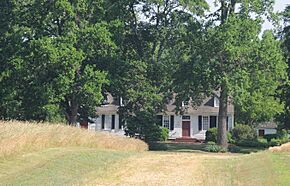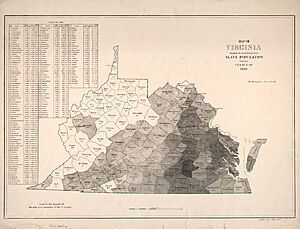Belle Air Plantation facts for kids
|
Belle Air
|
|

Belle Air in May 2019
|
|
| Location | Charles City County, Virginia near Charles City, Virginia, U.S. |
|---|---|
| Area | 135 acres (55 ha) |
| Built | Circa 1725–40 |
| Architectural style | Vernacular |
| NRHP reference No. | 74002232 |
Quick facts for kids Significant dates |
|
| Added to NRHP | July 18, 1974 |
Belle Air is a very old house and farm located by the James River in Charles City, Virginia. It's in a part of Virginia called the Tidewater. For a long time, starting in the late 1600s, this farm was home to families who owned enslaved people. The house you see today was likely built in the early 1700s. In 1974, Belle Air was added to the National Register of Historic Places. This means it's an important historical site because it's a great example of an old building style from the time of King William III and Queen Mary II.
History of Belle Air
Belle Air was lived in almost constantly from the late 1600s until the early 1900s by different families in Virginia. In the 1950s, Mr. and Mrs. Walter O. Major bought the property. They worked hard to fix up the old house and turned it into a museum that people could visit.
The Majors did a lot of research to find out who owned the property in the past. They believed that the first owner was Thomas Stegg Jr.. He inherited the land from his father in 1652. Stegg supposedly started building the first main house in 1655.
Later, in 1662, a man named David Clarke bought part of Stegg's land, including the first house. He called his new property "Windsor." Clarke's family owned the land until 1800. During this time, the current house was built, probably between 1725 and 1740. The property also got its new name, "Belle Air."
The Willcox family then owned Belle Air until 1945. The house was probably empty for some time in the 1920s. The Majors' research helped Belle Air get listed on the Virginia Landmarks Register and the National Register of Historic Places in 1974. This history is still generally accepted today.
However, in 1994, a family history expert named David Thomas Bradford disagreed with some of the Majors' findings. He believed that his own ancestor, Richard Bradford I, actually owned the farm from the 1650s until 1729. Bradford thought the current house was built after his family left the property in the late 1720s.
Life on the Plantation: Slavery
The people who owned Belle Air Plantation also owned enslaved people. Slavery was very common in southeastern Virginia. In this area, there were more enslaved people than free people. The economy here depended on growing crops like tobacco.
Slavery connected Virginia to a larger world of trade and helped wealthy plantation owners become powerful. Enslaved people were considered property and were forced to work without pay. Their labor created a lot of wealth for the state. For example, in 1832, the value of enslaved people in Virginia was estimated to be about one-third of all the wealth in the state.
Because plantation owners had so much wealth and influence, they had a lot of power in the government. Enslaved people often resisted their forced labor. There were major rebellions, like in 1800 and 1831. These acts of resistance led plantation owners to create even stricter rules to control enslaved people before the American Civil War.
Enslaved people in Virginia did many different kinds of work, not just farm labor. Many were skilled workers. By the late 1700s, most enslaved people in Virginia were born in North America. In 1860, just before the Civil War, enslaved people made up 62% of all the people in Charles City County.
Architecture of Belle Air
Belle Air is a special example of an old wooden house. It has exposed wooden beams inside, which is a style from the post-medieval period. It might be the oldest plantation house still standing along State Route 5.
The main part of Belle Air has design features from the 1600s, but its layout and window placement are more like 1700s designs. The exposed wooden beams inside are unique for a wooden building in Virginia. These beams are not just for support; they are also part of the house's decoration. Large "summer beams" run through the middle of the ceilings and into the chimneys. These beams are the main supports for the floors above.
On the property, there is also an old wooden smokehouse with a pointed roof and a wooden kitchen building.
See also


